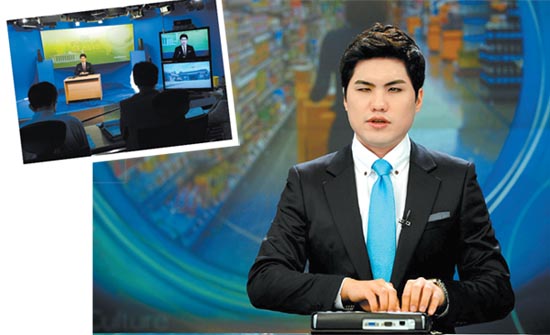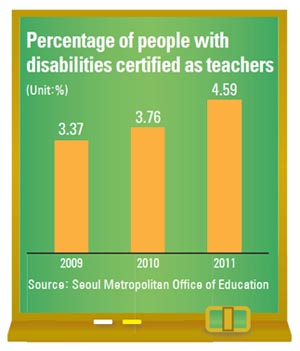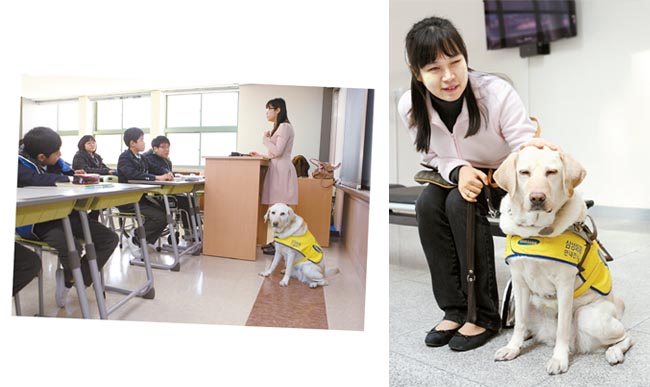People with disabilities break new ground in employment

Lee Chang-hun, who lost his sight when he was seven months old, does a final screen test to become a newscaster at KBS in July. Lee beat out 522 other people to win the position and made his debut on Nov. 7. Lee reads using a Braille notebook. Provided by KBS
Dressed in a dark navy business suit with neatly combed hair and perfectly applied makeup, Lee Chang-hun was rehearsing his segment for a live news broadcast last week at KBS. His voice was quiet, yet deep and resonant. As he went over the text, his index finger slid quickly across the Braille notebook placed on his lap.
The notebook, the Braille embosser next to him and the movements of his eyes were the only traces of his visual impairment.
Lee lost his sight when he was seven months old due to encephalomeningitis but hasn’t let that cloud his vision of a career in broadcast journalism.
Now, he is the newest addition to the KBS news team and will deliver soft news from Monday to Friday for a year. His appointment is part of a broader plan announced by KBS in April to give “opportunities to aspiring anchors who are also people with disabilities.”
It was an iconic decision not only because a major broadcasting station is featuring a newscaster who is disabled, but also because the coveted job was given to a person with a visual impairment in a nation where the majority of the blind are still educated to become masseurs when they finish their formal schooling.
Lee beat out 522 other applicants with disabilities for the position last July.
“I had to try because a chance like this doesn’t come along that often,” Lee said after he had come off the air. “As I was approaching the final stage of the application process, I was rather curious to know how far I could go.”
Lee’s appointment has turned out to be a life-changing experience not only for him, but also for KBS.
The broadcaster installed canary yellow tactile paving within the newsroom to help Lee navigate the space and obtained a high-end Braille printer and computer. They also hired an assistant for Lee to guide him through the studio and facilitate his interactions with staff.
Yet there were significant obstacles to bringing Lee on board.
“We have manuals for rookie newscasters, but we didn’t have ones for people with disabilities like Lee,” said Lim Heung-sun, director of KBS’s science and disaster department. Lim has been in charge of training Lee in his new position over the past three months.
“During training, it’s more effective if you can watch what’s going on, but Lee has had to rely on verbal education,” Lim said. “In addition to that, reporters usually become anchors after more than 10 years of experience, but Lee has no experience at all. His lack of knowledge of current affairs was the biggest problem we had to tackle.”

“Although we hired Lee, some top officials were skeptical about Lee doing a live news show every day,” Lim said. “Some of them proposed taping Lee’s segment as a way to reduce risks or having him deliver news for just a few days a week.
“But I said no. Everyone does the show live, and I told them that if Lee filmed his segment in advance, it would be like drawing a line between him and the sighted anchors.”
Lee, who used to host a streaming Internet radio show for the blind as a hobby, made his broadcast television debut on Nov. 7. It was definitely a moment to be remembered in the nation’s broadcast history.
Lee signed a one-year contract with KBS, but Lim said that if he does well, he could be put in charge of other news shows when his contract expires.
Though he has landed a dream job, Lee is modest about his accomplishment.
“I’ve lived most of my life as a student, but now I have a job. And I feel flattered that I can contribute to society in this way. I’m happy,” he said with a grin.
Like Lee, a majority of people with physical and mental disabilities still struggle to find jobs. And even when they do find employment, most of them end up with menial, mostly blue-collar jobs.
According to the Korea Employment Agency for the Disabled, the unemployment rate for disabled Koreans is almost double that of the able-bodied.
As of May 2010, the unemployment rate for disabled Koreans stood at 6.6 percent, while it was 3.2 percent for the able-bodied.
Since its launch in 1990, the KEAD has been trying to increase job opportunities for the disabled by implementing a quota for companies with more than 50 workers.
“At a company with more than 50 employees, people with disabilities must make up 2.3 percent of the workforce or the company will face fines,” said Kim Hyun-ju, a public relations official at the KEAD.
Thanks in part to efforts initiated by the KEAD and other organizations, people with disabilities now have a broader range of job opportunities.

Kim Kyung-min teaches English as her guide dog Mi-dam stands ready to assist, left, and right, the two pose for a photo at Inwang Middle School in Hongje-dong, Seodaemun District, northern Seoul. Kim passed the state-run teacher certification test last year and has been teaching at the school since March. Provided by Samsung Guide Dog School
Kim Kyung-min, 23, teaches English at Inwang Middle School, Hongje-dong, Seodaemun District, northern Seoul. She is one of only a few teachers with disabilities who work at regular schools as opposed to schools for the blind.
What differentiates Kim from her coworkers is that she is always accompanied by her furry four-legged partner Mi-dam, a guide dog that was given to her by Samsung Fire & Marine Insurance five years ago.
After graduating with honors from Sookmyung Women’s University’s liberal arts college last year, Kim passed the state’s teacher certification exam, which typically takes from one to three or four years for sighted people to pass.
“People like me couldn’t apply for teaching jobs at ordinary public schools when I was a high school student, but back when I was in high school, I made up my mind to teach in an ordinary school,” Kim said in a telephone interview. “But my parents were against my decision. They wanted me to work at schools for the blind. They told me I should follow the mainstream.
“Surprisingly, it became possible for people with disabilities to teach at ordinary public schools a couple of years later.”
Born with a visual impairment, Kim underwent 26 optical surgeries before she turned eight, but none corrected her vision.
Kim can’t see completely, but she teaches her turbulent teen students without major problems. Along with her seven-year-old dog, she has a human assistant, hired by the Seoul Metropolitan Office of Education, who Kim says sees for her.
“I would say that she is my eyes for your better understanding,” Kim said. “For instance, I need to mark my students’ homework, but I can’t see it. My assistant explains the students’ answers to me in words.”
On her first day at school in March, Kim said she told her students about herself and her guide dog.
“I told them I’m different from them,” she said. “And I asked them to tell me their names whenever they say ‘hi.’ They all know how to treat Mi-dam as well.”
The Ministry of Education, Science and Technology changed the law regarding employment of teachers at public schools nationwide in 2009. Under the updated law, people like Kim and others with physical challenges can apply to take the teacher certification test.
As a result, the number of teachers with disabilities has continued to increase.
Kwak Yun-cheol, an Education Ministry official, said that people with disabilities made up 3.37 percent of the total number of people who passed the teacher certification exam in 2009.
“But the figure went up to 3.76 in 2010 and 4.59 this year,” he said.
With state-run organizations providing people with disabilities more legitimate job opportunities, private companies have followed.
Take NHN, operator of Naver, the country’s biggest Web portal, as an example. Its affiliate, N Visions, has sponsored the permanent exhibition “Dialogue in the Dark” since February 2010. Since it premiered in Germany in 1988, the exhibition has been experienced by more than 6 million people in 25 countries. People are allowed to touch and feel ordinary objects and experience everyday situations, such as crossing the road, in the total darkness with the aid of a guide who is visually impaired.
“About 80 percent of its [N Visions’] employees are blind,” said Kim Cheong, an official at NHN.
Meanwhile, Korean Air, the nation’s biggest carrier, has about 160 physically challenged employees, and they handle such jobs as issuing tickets or dealing with customers.
People with disabilities are often segregated during their education in Korea. But bringing those with disabilities together with the able-bodied may go a long way toward bringing further change. And with more people with disabilities working in public and private organizations, able-bodied people have become more interested in getting to know this previously isolated group of people.
“I didn’t know much about differently-abled people before I started working with Lee,” said Lim, the KBS supervisor. “But because I was involved in the recruiting process, I’ve come to know more about them. The older generation like me tends to think of the blind as incompetent and needy, but I’ve realized they are not that way at all. There were many qualified applicants [for Lee’s job].”
So why is it still hard for people with disabilities to find jobs? The answer is simple.
“We know,” said Kim at the Korea Employment Agency for the Disabled. “In the end, it’s a matter of social bias.”
By Sung So-young [so@joongang.co.kr]










with the Korea JoongAng Daily
To write comments, please log in to one of the accounts.
Standards Board Policy (0/250자)